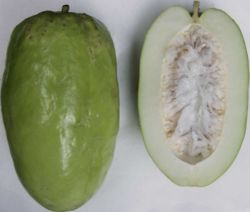| Badea/Giant Granadilla {{{status}}} Fossil range: {{{fossil_range}}}
|

Full and longitudinally-cut badeas
|
| Plant Info
|
| Common name(s):
|
|
{{{common_names}}}
|
| Growth habit:
|
|
{{{growth_habit}}}
|
| Height:
|
⇕
|
{{{high}}}
|
| Width:
|
⇔
|
{{{wide}}}
|
| Lifespan:
|
⌛
|
{{{lifespan}}}
|
| Exposure:
|
☼
|
{{{exposure}}}
|
| Water:
|
☂
|
{{{water}}}
|
| Features:
|
❀
|
{{{features}}}
|
| Poisonous:
|
☠
|
{{{poisonous}}}
|
| Hardiness:
|
❆
|
{{{hardiness}}}
|
| USDA Zones:
|
|
{{{usda_zones}}}
|
| Sunset Zones:
|
|
{{{sunset_zones}}}
|
|
| Scientific classification
|
| Domain:
|
{{{domain}}}
|
| Superkingdom:
|
{{{superregnum}}}
|
| Kingdom:
|
Plantae
|
| Subkingdom:
|
{{{subregnum}}}
|
| Superdivision:
|
{{{superdivisio}}}
|
| Superphylum:
|
{{{superphylum}}}
|
| Division:
|
Magnoliophyta
|
| Phylum:
|
{{{phylum}}}
|
| Subdivision:
|
{{{subdivisio}}}
|
| Subphylum:
|
{{{subphylum}}}
|
| Infraphylum:
|
{{{infraphylum}}}
|
| Microphylum:
|
{{{microphylum}}}
|
| Nanophylum:
|
{{{nanophylum}}}
|
| Superclass:
|
{{{superclassis}}}
|
| Class:
|
Magnoliopsida
|
| Sublass:
|
{{{subclassis}}}
|
| Infraclass:
|
{{{infraclassis}}}
|
| Superorder:
|
{{{superordo}}}
|
| Order:
|
Malpighiales
|
| Suborder:
|
{{{subordo}}}
|
| Infraorder:
|
{{{infraordo}}}
|
| Superfamily:
|
{{{superfamilia}}}
|
| Family:
|
Passifloraceae
|
| Subfamily:
|
{{{subfamilia}}}
|
| Supertribe:
|
{{{supertribus}}}
|
| Tribe:
|
{{{tribus}}}
|
| Subtribe:
|
{{{subtribus}}}
|
| Genus:
|
Passiflora
|
| Subgenus:
|
{{{subgenus}}}
|
| Section:
|
{{{sectio}}}
|
| Series:
|
{{{series}}}
|
| Species:
|
P. quadrangularis
|
| Subspecies:
|
{{{subspecies}}}
|
|
| [[{{{diversity_link}}}|Diversity]]
|
| {{{diversity}}}
|
| Binomial name
|
Passiflora quadrangularis
Triana & Planch
|
| Trinomial name
|
{{{trinomial}}}
|
| Type Species
|
{{{type_species}}}
|
| {{{subdivision_ranks}}}
|
|
|
[[Image:{{{range_map}}}|{{{range_map_width}}}|]]
|
| Synonyms
|
| {{{synonyms}}}
|
The Giant Granadilla or Badea (Spanish: [ba.ˈð̞e.a]), Passiflora quadrangularis, is the largest of the passionfruits, plants of the genus Passiflora. It is a perennial native of tropical America, having smooth, cordate, ovate or acuminate leaves; petioles bearing from 4 to 6 glands; an emetic and narcotic root; scented flowers; and a large, oblong fruit, containing numerous seeds, imbedded in a subacid edible pulp.
The badea is sometimes grown in greenhouses. The fruits of several other species of Passiflora are eaten. P. laurifolia is the Water lemon, and P. maliformis the Sweet calabash of the West Indies.
The fruit juice of the badea is used as a beverage.
References
